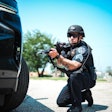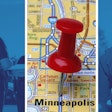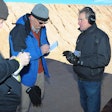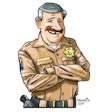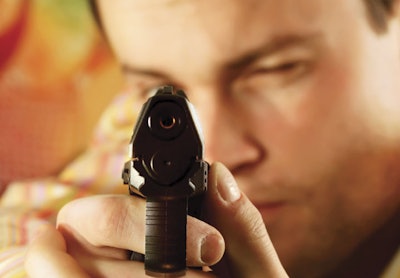 Photo: iStockPhoto.com
Photo: iStockPhoto.com
Having just returned from a business trip, John Haines decided to take his wife, Sarah, out to dinner. Things went well that evening of Feb. 18, 2009, until the meal's conclusion when John decided that he wanted to stay out drinking. Sarah told him not to come home.
Sarah's reservations about John's drunken return were not without foundation. The effects of alcohol on her husband's disposition, particularly when combined with his prescription medications, was something she'd become all too familiar with in recent months. To hedge her bets, she threw John's suitcases on the front lawn. What she hadn't known at the time was that one of the suitcases contained two handguns.
John returned to his house on Golden Talon Avenue in Las Vegas at 10:30 p.m., found the suitcases, and opened them. Retrieving the firearms, he walked to his front door and knocked on it. At the sight of her husband standing on the front porch holding a gun to his head, Sarah dialed 911.
Officers of the Las Vegas Metro Police Department were dispatched to the scene.
Sarah told John Las Vegas' finest were en route. He retreated to his front lawn. John had a blood alcohol level of .21 percent and a good amount of methadone coursing through his system. So it's small wonder that the thought of a curbside respite seemed appealing to the 30-year-old. He plopped down behind a parked car and placed a call to his father on his cellular phone. He remained there sitting on the curb for the better part of the next 30 minutes, apprising his father of the events that he'd put into motion.
Las Vegas Metro PD patrol personnel arrived on scene within a few minutes of Sarah's 911 call. They effected a containment of the suspect and the location. Several officers—some with long guns—took cover positions about the scene as a crisis negotiator, Officer Jeremy Landers, initiated a one-on-one dialogue with John.
For the moment, everything was as good as could be expected. Yes, the man was armed and distraught. But John Haines was bottled up and the only immediate threat he posed to anyone was the man he had the guns trained on: Himself.
Command Decision
As both the shift and area commander that evening, Lt. Randy Sutton had been monitoring the situation from the time the call was dispatched. He arrived at the scene nearly 15 minutes later, and found John still seated on the curb outside his residence, a gun to each side of his addled head. The negotiator, Landers, was still doing his thing, trying every trick in the book to first gain the man's attention and then his trust. But throughout John remained wholly uncommunicative with anyone save for his father on the other end of the cell phone.
Sutton was for the most part pleased with how things were evolving tactically. But one thing concerned him: Neither the wife nor baby had been evacuated from Haines' house.
Sutton directed a team to enter the backyard of the property and extract Sarah and the child through the back of the house. But the officers had barely entered the backyard when John Haines jumped up from the curb and started running for the front door.
Although he'd been on scene for a mere two minutes, Sutton's hand was already being forced.
22 Rounds
"He is not to get inside the house!"
Sutton's command to inner containment personnel left no ambiguities. Too many suicidal men had proven susceptible to the notion of taking loved ones with them, and with two firearms at his disposal Haines was more than capable of doing the same.
The same professionalism that had guided each and every officer on containment did not abandon them, and at the moment when Sutton was about to reach the front door, those officers with a viable shot took it. Of the 22 rounds fired a split-second later, seven found their mark.[PAGEBREAK]John Haines' forward momentum pitched him into a flower bed. As officers converged upon his body, they saw that his T-shirt had ridden up on his torso exposing a tattoo on his abdomen that read, "Psycho." Two semi-automatic firearms were recovered from the scene and John "Psycho" Haines was pronounced dead a short time thereafter.
Debriefings
"This was a pretty cut-and-dried suicide by cop," notes Sutton. "Not only had Haines told his father that he was going to have the cops kill him, but he'd even left the line on the cell phone open when he got up to charge the door. He knew what was going to happen and wanted his father to hear it when it did."
The weapons fired by six on-scene officers—Lt. Randy Sutton, Landers, Charon Griswold, Jason Hardwick, Christopher Sjoblom, and Marc Ashbock—included three handguns, two shotguns, and an AR-15 rifle. As one of several officers that had taken cover behind a car in a neighboring driveway, Sutton fired one round from his .45 Glock.
"He was 75 feet from me and I had a good visual on him," recalls Sutton. "I fired one round because as soon as the guy with the AR-15 fired, he went down quickly."
Sutton is complimentary to all the officers involved that night, noting the absence of contagion fire. Several officers did not engage because they did not have good target acquisition or their fields of fire weren't optimal.
Sutton notes that negotiator Landers had his work cut out for him, as the chemicals detected in Haines' autopsy would have amplified the effects of one another.
"I had no conversation with him," reflects Sutton. "Landers was the only guy doing the negotiation with him. You can't have a lot of people jumping into that. He did all he could to establish a rapport and try to lower Haines' stress and get him to put the guns down and talk. But the man just wasn't having any of it."
While Landers was able to successfully transition from negotiator to shooter when the situation demanded it, he still wished that the incident could have ended differently. "I would have stayed out there all night talking with him," the officer told a journalist later.
That had plainly ceased to be an option the moment Haines stood up and charged in the direction of his wife and child.
"As soon as I saw him stand up, in my own mind he was going to do one of two things: Either rush the officers, or try to get back in the house," says Sutton. "If he was going to rush the officers, then I wouldn't have had to give the order because they would do what they'd have to do. But if he was going to try to get into the house, that’s a different set of circumstances because his wife and child's safety had to be the number one thing on my mind then. I made the determination that there was no way I was going to allow him to get back into that house. I needed to help those guys make that decision."
A Different Feeling
Las Vegas Metro PD conducts formalized debriefings as part of its employee assistance program. Under the care of counselors, all of the officers involved discussed the incident at length for hours. Each officer described his individual impression about what occurred.
"That was very helpful to me," explains Sutton. "In that setting, we were all together. All of the officers that were there said they felt that my giving that command was the right decision. It eased their minds when I gave that command. It helped them later on deal with the emotional turmoil of it."
While Sutton has no regrets about the decision he made, he candidly acknowledges that the decision was not made lightly, and it did not come without some cost to all involved—himself included.
"This was my fifth shooting. This was different for me because all of the other shootings were me against them in a single combat situation. This was a little different because I was commander at the scene. So I had not only my own issues to deal with, but also keeping my officers safe, making tactical decisions, basically giving the order to fire. That played a little havoc with me for a little bit. It's different when you are the one making the single decision about your actions. It's different when you are telling other officers to take a life. That's basically what the situation was.
"When you're tactical commander, like on a SWAT team, you're making that decision all the time. But when you're a patrol commander, that situation doesn't arise very often. So giving that order, which was tantamount to ordering the death of another human being, is different and it plays differently in your mind than just you making a decision about your own personal combat," Sutton explains.
Legacy
The Clark County coroner's inquest into Haines' shooting coupled with the death of his mother found the lieutenant on leave for an extended period of time. Shortly after his return to work, Sutton suffered an on-duty stroke that resulted in his medical retirement from the department.
"It's kind of some weird irony that one of the last official acts of my career would be a fatal shooting," the 55-year-old reflects. "That's something that rises to the thoughts of what lies in store for all of us. What are the thought processes and how does fate play a role in all of our lives? It's certainly not what I would like to be remembered for, for one of my last official acts as a cop. Those officers that were there under my command that night, it's how they view me that will truly be what my legacy will be."
The legacies that men leave during the course of their lives is something that Sutton continues to concern himself with. Today, he is hard at work on a Website designed to give comfort to those left behind after a loved one’s death.
"The Website is designed to celebrate lives—past, present, and future—and leave personal legacies behind for generations. This is the most important thing that I have done, and it is the result of my life experiences. As such, I don't view them as negatives but simply as facets of my past. If I allowed myself to wallow in negativity because of any of it, I would be defeated. And that word is not in my vocabulary."
The Website is already receiving 1,000 visits a week, which Sutton says is very good because it's just a demonstration site. "I can't wait until this thing gets out and we can start touching lives," he says.











